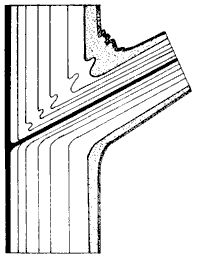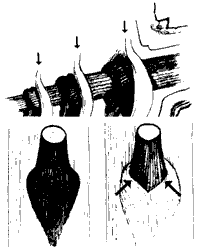From the Archives
of the Rare Fruit Council of Australia, inc.
by Peter Brown, Extract from Australian Horticulture August, 1986

Understanding Tree Anatomy for Improved Plant Growth
The difficulties in understanding tree anatomy have become
increasingly compounded over the years by what were once assumptions
later being taken as fact. A real understanding of tree anatomy and
growth may now require a complete rethinking of what we have learned
and since believed to be true.
At least that is a conclusion
which may be drawn from recent research, published in the Canadian
Journal of Botany 'How Tree Branches are Attached to Trunks', which
shows how fundamental some of these assumptions can be. The research
was conducted by Dr. Alex Shiga, who presented it to Australian
horticulturists on a lecture tour sponsored by Rivett Enterprises
earlier this year.
Established thinking on the arrangement of
woody tissues in trees suggested they were continuous between the
branch and trunk. While this is undoubtedly true, it may not come about
in the way many imagine. The left hand diagram shows the presumed
arrangement of tissues given in most textbooks, while the right hand
one summarises Dr. Shiga's recent findings. This picture was developed
from a range of dissections and other studies, made over successive
periods throughout the growth cycle.
 |  | | Incorrect diagram of branch growth | A better diagram of branch growth |
He
discovered that branch tissues develop first, beginning early in the
season and maturing from the tip towards the base. At the junction with
the trunk, they turn abruptly downwards, forming a shield-shaped
collar. Later in the season, the trunk wood develops and forms a second
collar around the branch and over the first one. Thus, the union of
branch and trunk grows and is strengthened, by a series of overlapping
collars.
Top
Implications for Tree Care
If
the upper tissues of the branch were continuous with the trunk wood
above it (left hand diagram), upward movement of water and solutes from
the roots would have only two possible ways of passing a branch. Such
movement would either rely on sideways movement between individual
vessels or would need to move along the lower tissues of the branch and
return along the upper tissues before continuing up the trunk. There is
no evidence to suggest that the second process occurs at all and Dr.
Shiga's previous work on decay compartmentalisation suggests that the
first would at least be very limited.
However, the organisation
of tissues shown on the right suggests that no connection between the
branch wood and that of the trunk above it exists and that upward
movement of water and solutes (other than that destined for the branch
itself) is not impeded or diverted by the branch connection.
This
helps explain why decay, progressing into the trunk from a branch
wound, does not seem to affect wood above the branch. On the other
hand, an injury or pruning cut which damages the collars will lead to
decay above (as well as below) the branch by direct exposure of these
tissues.
It is also easy to see, from this picture of the branch
connection that the weakest point will be in the angle of the crotch.
This may support the belief that a weaker branch connection occurs with
a more acute crotch angle, but from this current research it is not
clear exactly how this is so.
 | | Photos and diagrams of branch growth |
Above:
branch connections on a Red Maple. Here the branch has died, but the
collars are undamaged. Inside the tree (Right) decay progresses towards
the centre of the trunk but is restricted by the branch collars. The
surrounding tissues remain healthy and unaffected. The line A-B shows
where the branch may be safely cut away. Cutting closer to the trunk
would damage the collars and cause extensive decay of the trunk wood.
For Growth
The
timing of growth is also important. If the strength of branch
connections is dependant upon the formation of an interlocking series
of collars then management practices which encourage their formation
may produce a stronger, healthier tree.
In an interview with
Australian Horticulture, Alex Shiga suggested that in some ways we may
be caring for trees too much, particularly in nurseries. "We place too
much emphasis on stem growth and girth," he said. "Fertilizer is not
simply good. We should look for ways of encouraging the right kind of
growth at the right time, rather than just producing more plants,
faster," Dr. Shiga explained.
This is particularly important for
growers of advanced plants as Dr. Shiga believes they may be producing
trees that will become weak and dangerous in years to come. He also
said that differences in growth timing between stock and scion may be
an important factor influencing the long term compatibility of some
graft unions.
Alex Shiga has been a tireless researcher for many
years and has published numerous papers on a wide variety of
tree-related topics. He now sees his role as more of an educator than a
researcher and it may be hoped that other lecture tours, like the one
he completed in March this year, will follow in the future. On this
trip, he spoke on many subjects including the timing of certain tree
work practices, programmed maintenance, branch attachment, the good and
bad of fertilisers and how compartmentalisation of extensive decay can
lead to the 'starvation' of a tree.
For further reading: Canadian Journal of Botany Volume 63, Number 8, 1985 - pages 1391-1401. 'How Branches are Attached to Trunks', Alex Shiga.
Back to
Planting and Growing Page
Top
|
|



